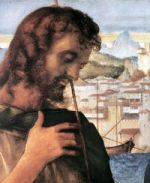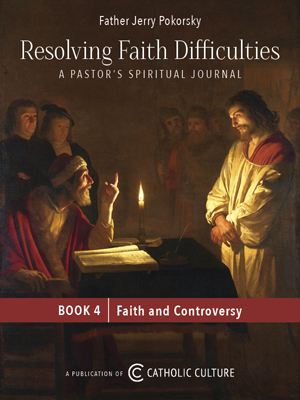Glory of the Trinity in Christ's Ascension
1. The mystery of Christ's Passover involves the history of humanity, but at the same time it transcends it. Thought itself and human language can in some way grasp and communicate this mystery, but do not exhaust it. For this reason, the New Testament, although speaking of "resurrection", as attested by the ancient Creed which Paul himself received and passes on in his First Letter to the Corinthians (cf. 15:3-5), also uses another expression to explain the meaning of Easter. Especially in John and Paul it is presented as the exaltation or glorification of the Crucified One. Thus, for the fourth Evangelist, the Cross of Christ is already the royal throne which stands on earth but penetrates the heavens. Christ is seated on it as the Saviour and Lord of history.
Jesus, in fact, exclaims in the Gospel of John: "I, when I am lifted up from the earth, will draw all men to myself" (12:32; cf. 3:14; 8:28). In the hymn inserted in the Letter to the Philippians, Paul, after describing the profound humiliation of the Son of God in his death on a cross, celebrates Easter in this way: "Therefore God has highly exalted him and bestowed on him the name which is above every name, that at the name of Jesus every knee should bow, in heaven and on earth and under the earth, and every tongue confess that Jesus Christ is Lord, to the glory of God the Father" (Phil 2:9-11).
2. Christ's Ascension into heaven, recounted by Luke as the seal to his Gospel and the beginning of his second work, the Acts of the Apostles, should be understood in this same light. It is Jesus' final appearance which "ends with the irreversible entry of his humanity into divine glory, symbolized by the cloud and by heaven" (Catechism of the Catholic Church, n. 659). Heaven is the sign of divine transcendence par excellence. It is the cosmic realm that lies above the earthly horizon within which human existence unfolds.
After walking the paths of history and entering even the darkness of death, the limits of our finitude and the wages of sin (cf. Rom 6:23), Christ returns to the glory which he shares from eternity (cf. Jn 17:5) with the Father and the Holy Spirit. And he takes redeemed humanity with him. In fact, the Letter to the Ephesians says that "God, who is rich in mercy, out of the great love with which he loved us, ... made us alive together with Christ ... and made us sit with him in the heavenly places" (Eph 2:4-6). This applies first of all to Mary, the Mother of Jesus, whose Assumption is the first-fruits of our ascension into glory.
3. We pause before the glorious Christ of the Ascension to contemplate the presence of the whole Trinity. We know that Christian art, in the so-called Trinitas in cruce, has often depicted the crucified Christ with the Father leaning over him as if in an embrace, while the dove of the Holy Spirit hovers between them (for example, Masaccio in the Church of Santa Maria Novella in Florence). In this way the Cross is a unifying symbol that joins humanity and divinity, death and life, suffering and glory.
In a similar way we can glimpse the presence of the three divine Persons in the Ascension scene. Luke, on the last page of his Gospel, before presenting the Risen One who, as the priest of the New Covenant, blesses his disciples and is lifted up from the earth to be taken into heavenly glory (cf. Lk 24:50-52), recalls his farewell discourse to the Apostles. In it we see above all the saving plan of the Father, who in the Scriptures had foretold the Death and Resurrection of the Son, the source of forgiveness and liberation (cf. Lk 24:45-47).
4. But in those same words of the Risen One we also glimpse the Holy Spirit, whose presence will be the source of strength and apostolic witness: "I send the promise of my Father upon you; but stay in the city, until you are clothed with power from on high" (Lk 24:49). If in John's Gospel the Paraclete is promised by Christ, for Luke the gift of the Spirit is also part of a promise made by the Father himself.
The whole Trinity is therefore present at the moment when the time of the Church begins. This is what Luke emphasizes in the second account of Christ's Ascension, in the Acts of the Apostles. Jesus, in fact, exhorts his disciples "to wait for the promise of the Father", that is, to "be baptized with the Holy Spirit", at Pentecost which is now imminent (cf. Acts 1:4-5).
5. The Ascension, then, is a Trinitarian epiphany which indicates the goal to which personal and universal history is hastening. Even if our mortal body dissolves into the dust of the earth, our whole redeemed self is directed on high to God, following Christ as our guide.
Sustained by this joyful certainty, we turn to the mystery of God the Father, the Son and the Spirit, which is revealed in the glorious Cross of the risen Christ, with the adoring prayer of Bl. Elizabeth of the Trinity: "O my God, Trinity whom I adore, help me to forget myself entirely that I may be established in you as still and peaceful as if my soul were already in eternity.... Give peace to my soul; make it your heaven, your beloved dwelling and your resting place.... O my Three, my All, my Beatitude, infinite Solitude, Immensity in which I lose myself, I surrender myself to you ..., until I depart to contemplate in your light the abyss of your greatness" (Prayer to the Blessed Trinity, 21 November 1904).
To the English-speaking visitors and pilgrims the Holy Father said:
I warmly greet the students of the Pontifical Beda College who will be ordained to the diaconate tomorrow, and are here today with their families. May God strengthen and guide you in your service of the Church. Upon all the English-speaking pilgrims and visitors, especially those from England, Finland, India, Australia, Japan and the United States, I invoke the joy and peace of the risen Lord.
© L'Osservatore Romano, Editorial and Management Offices, Via del Pellegrino, 00120, Vatican City, Europe, Telephone 39/6/698.99.390.
This item 2821 digitally provided courtesy of CatholicCulture.org






